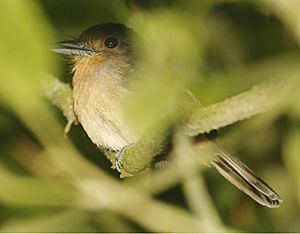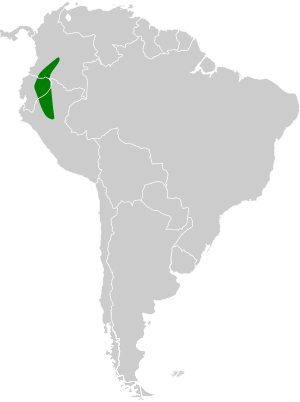Brown nunlet facts for kids
Quick facts for kids Brown nunlet |
|
|---|---|
 |
|
| Conservation status | |
| Scientific classification | |
| Genus: |
Nonnula
|
| Species: |
brunnea
|
 |
|
The brown nunlet (Nonnula brunnea) is a small bird that lives in the forests of South America. It belongs to a bird family called Bucconidae, which includes puffbirds, nunlets, and nunbirds. You can find this bird in Colombia, Ecuador, and Peru.
Contents
About the Brown Nunlet's Family
The brown nunlet is a unique bird, meaning it's the only one of its kind in its specific group. Scientists believe it's closely related to other nunlets like the rusty-breasted nunlet and the fulvous-chinned nunlet. These birds might even be part of a "superspecies," which is a group of very similar species.
What Does the Brown Nunlet Look Like?
The brown nunlet is about 14 to 15 centimeters (about 5.5 to 6 inches) long.
- Its head and back are a plain brown color.
- It has a light, reddish-yellow band that goes from its beak to its eye.
- There's a thin, light ring around its eye.
- Its cheeks are a dark grayish-brown.
- The bird's throat and sides are a dark reddish-yellow.
- Its chin and chest are a lighter reddish-yellow.
- The belly is also a light reddish-yellow color.
- Its beak, eyes, and feet are dark.
Where Does the Brown Nunlet Live?
Brown nunlets live in a part of South America that stretches from south-central Colombia, through eastern Ecuador, and into northern Peru. They prefer to live in wet, lowland forests that have not been cut down, or in thick secondary forest (forest that has grown back after being cleared). These birds usually stay low in the forest, below the tops of the trees. In Ecuador, they are mostly found below 400 meters (about 1,300 feet) in elevation, but they have been seen as high as 700 meters (about 2,300 feet).
How Does the Brown Nunlet Live?
What Does the Brown Nunlet Eat?
Not much is known about what brown nunlets eat or how they find their food. However, they have been seen joining groups of other small birds called antwrens.
How Does the Brown Nunlet Make Babies?
Scientists have found one brown nunlet nest. It was a small ditch dug in the ground and covered with sticks and leaves to make a roof. A close relative, the rusty-breasted nunlet, also builds a shallow nest that it covers with twigs and leaves. That type of nunlet usually lays four eggs.
What Does the Brown Nunlet Sound Like?
The brown nunlet's song is a series of 20 to 25 "treeu" notes. It repeats these notes steadily, starting quietly, getting louder, and then fading away at the end.
Is the Brown Nunlet Safe?
The IUCN (International Union for Conservation of Nature) has listed the brown nunlet as a species of "Least Concern". This means it's not currently in danger of disappearing. However, scientists don't know exactly how many brown nunlets there are, and they believe the number might be going down. It seems to be a rare or uncommon bird throughout the areas where it lives.
See also
 In Spanish: Monjita canela para niños
In Spanish: Monjita canela para niños


